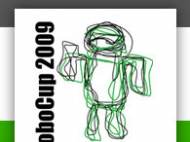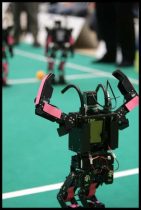Robocup 2009 – world’s largest robotics competition
 The world’s largest robotics competition, Robocup 2009 took place in the southern Austrian city of Graz, from 29th June to 5th July. Robocup is an international competition that started in 1997 in Nagoya, Japan. Its aim is to develop autonomous football robots in order to promote interest and research in the field of artificial intelligence. There are other components to the competition including a search and rescue category and a robotic dance off. In this article we’re going to write about the football competition and a robot from that category, and in our future articles we’re going to write about some of the robots from other categories.
The world’s largest robotics competition, Robocup 2009 took place in the southern Austrian city of Graz, from 29th June to 5th July. Robocup is an international competition that started in 1997 in Nagoya, Japan. Its aim is to develop autonomous football robots in order to promote interest and research in the field of artificial intelligence. There are other components to the competition including a search and rescue category and a robotic dance off. In this article we’re going to write about the football competition and a robot from that category, and in our future articles we’re going to write about some of the robots from other categories.
The official goal of the Robocup project is to provide a team of fully autonomous humanoid robot soccer players shall win the soccer game, complying with the official rule of the FIFA, against the winner of the most recent World Cup, by mid-21st century. This is an ambitious prospect but every year the competition progresses in leaps and bounds.
Dribbling, attacking and defending, our footballer robots kick-start major progress in the field of artificial intelligence research: the robot football tournament is a unique scientific showcase event that makes robotic research comparable while treating the audience to an exciting competition. At the RoboCup 2009 in Graz, the artificial players will compete in five leagues – on two legs, on wheels or just “virtually” on the monitor.
It is the combination of high speed with dynamic and complex movement patterns that has made football the most popular of all robot sports disciplines. Football presents major challenges for robots. They need to take the initiative and engage in action in a real environment. They need to recognize objects such as the ball. They need to establish their own and other players’ positions, respond to counterattacks, plan their movements, execute movements and ultimately put the ball in the right goal. Matches are played in two halves of 15 minutes each. All matches are played according to the FIFA rules, i.e. the rules of the World Football Federation for professional ‘human’ football, with just one exception: the offside rule does not apply to the intelligent robots.
Although making his debut for the RoboCup this year robot Nao conquered the hearts of the spectators. He is 58 centimeters tall and weights 4.3 kilograms, and has a white-red or blue humanoid body reminiscent of an astronaut. He also has two spherical eyes which flash in alternating colors. But despite the charm, he’s a highly intelligent, autonomous robot whose abilities will be put to the test in the Standard Platform League of the RoboCup 2009. With his appearance in the RoboCup, the two-legged Nao will relieve Sony’s four-legged Aibo who is going into a well-earned retirement after a successful RoboCup career.
Nao can smile, stick his head out to the side in a cheeky sort of way, and for a short moment you can almost forget that he’s a robot and not a human. He is one of the highlights of robotics research. He’s a very impressive autonomous robot – not just because of his design, but also because of his abilities and applications.
Nao, who was originally presented as an entertainment robot in his first version in 2005, comes from Aldebaran Robotics, a French robotics company. The “fun robot” was made into a valuable partner for robotics research and teaching.
Based on a Linux platform and freely programmable, Nao has an abundance of application possibilities and features. With an integrated computer and WLAN function, he can establish a secure internet connection and upload and download data. Nao can recognize and localize voices, reproduce any manner of sound via a sound system, record and send photos and videos, recognize faces and colored objects, and he can vocalize a variety of texts by means of text-to-speech function, such as emails which have been sent to him directly. And of course he can move. Thanks to 25 degrees of freedom, in other words axis movements, Nao can carry out plenty of movements. He can walk, sit, stand up, turn round, reach out to objects with his hands, turn his head, dance, kick and avoid obstacles. And he does it all by himself and completely autonomously.










Leave your response!